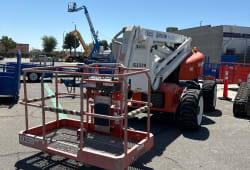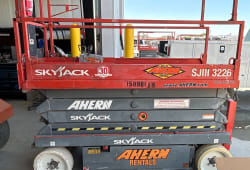Navigating the Road: A Comprehensive Guide to Flatbed Trailers
9 Min read
)
January 19, 2024
In the vast and dynamic world of transportation, flatbed trailers stand out as versatile workhorses capable of carrying a wide range of goods. Whether you're a seasoned trucker or a logistics enthusiast, understanding the ins and outs of this is essential for navigating the road effectively. This comprehensive guide will delve into the various aspects of flatbed trailers, from their design and types to loading techniques and safety considerations. These trailers, characterized by their open platforms, accommodate oversized cargo, machinery, and construction materials with ease. As we explore their features, we'll uncover the crucial role flatbed trailers play in ensuring efficient and secure transportation across diverse industries.
Introduction to Flatbed Trailers
Flatbed trailers, as the name suggests, feature an open and flat cargo area without the confines of walls or a roof. This design makes them ideal for transporting oversized and unconventional loads. From construction materials and machinery to large equipment, this plays a crucial role in the logistics industry. Let's explore the key components and types of flatbed trailers. The versatility of flatbeds allows for easy loading and unloading, making them indispensable for transporting goods that may exceed standard dimensions or require specialized handling.
Anatomy of a Flatbed Trailer
Understanding the anatomy of a flatbed trailer is the first step in appreciating its capabilities. Key components include the main deck, side rails, bulkhead, and the rear end. The main deck is where the cargo rests, supported by cross-members underneath. Side rails provide a boundary for the load, while the bulkhead at the front prevents it from shifting forward. The rear end may have ramps or other features for ease of loading and unloading. Familiarity with these elements ensures efficient and secure transport of various goods.
Types of Flatbed Trailers
Standard Flatbed Trailers
Flatbed trailers play a crucial role in transporting diverse loads. Standard flatbed trailers are the most common type, featuring a simple flat surface without any specialized additions. They are versatile and suitable for a wide range of cargo, making them the go-to choice for many trucking companies. These trailers provide flexibility for transporting goods of various shapes and sizes, ensuring efficient and reliable delivery across different industries.
Step Deck Trailers
Step deck trailers, also known as drop deck trailers, have a lower deck towards the rear, allowing for the transportation of taller cargo. This design facilitates the hauling of loads that may be too tall for a standard flatbed. Step deck trailers offer increased versatility in transporting various goods, making them ideal for industries requiring the carriage of oversized items while maintaining stability and complying with height restrictions in different regions.
Double Drop Trailers
Double drop trailers, or lowboy trailers, are specialized transport vehicles with an even lower deck, usually in both the front and rear sections. This unique design caters to the transportation of towering cargo, particularly suited for industrial equipment and machinery. The lowered configuration allows for the accommodation of exceptionally tall items, ensuring secure and efficient transport, making double drop trailers a preferred choice for industries requiring the movement of oversized and challenging loads.
Extendable Flatbed Trailers
Extendable flatbed trailers can be adjusted to accommodate longer cargo. This feature makes them versatile for transporting various load sizes while maintaining the benefits of a flatbed design.
Loading Techniques for Flatbed Trailers
Loading cargo onto a flatbed trailer requires careful planning and execution to ensure safety and efficiency. Here are some essential loading techniques:
Proper Weight Distribution
Proper weight distribution is critical to prevent imbalance and ensure the trailer remains stable during transit. Distributing the weight evenly across the entire length of the trailer helps maintain control and stability.
Securing the Load
Securing the load is of utmost importance to prevent shifting during transport. Straps, chains, and binders are commonly used to secure cargo to the flatbed. Ensuring tight and reliable connections is essential for safe transit.
Overhang Considerations
When loading oversized cargo, it's crucial to consider any overhang. Overhanging loads can create hazards for other drivers on the road, so understanding and complying with regulations regarding overhangs is essential.
Safety Considerations for Flatbed Trailers
Ensuring the safety of both the cargo and other road users is a top priority when operating them. Here are some safety considerations to keep in mind:
Inspections and Maintenance
To ensure the safe and efficient operation of a trailer, it is crucial to conduct regular inspections and maintenance. This includes checking for structural integrity, brake functionality, and the condition of securing mechanisms. Identifying and addressing potential issues promptly can prevent accidents and extend the lifespan of the trailer, ensuring a reliable and secure transportation system for goods and materials.
Load Limits and Regulations
Navigating the complexities of transportation demands diligence. Efficient routes, timely deliveries, and optimal cargo management contribute to a seamless supply chain. Understanding load limits and adhering to transportation regulations is vital. Exceeding weight limits not only poses safety risks but can also result in legal consequences. Familiarizing yourself with local and federal regulations is crucial for compliance, ensuring a smooth and lawful operation in the ever-evolving logistics landscape.
Weather and Road Conditions
Weather conditions can significantly impact the safety of transporting cargo on a flatbed trailer. High winds, rain, or snow can affect the stability of the load and the handling of the trailer. Monitoring weather forecasts and adjusting travel plans accordingly is a key safety measure. Adverse weather can lead to hazardous road conditions, making it imperative for truckers to stay informed and prioritize safety when transporting goods.
Advantages of Using Flatbed Trailers
They offer several advantages that contribute to their popularity in the transportation industry:
Versatility
In the realm of logistics, flatbed trucks stand out for their adaptability and efficiency. Their open design allows for the transportation of a diverse range of goods, from standard cargo to oversized and unconventional loads. This versatility makes flatbed trucks an indispensable choice for industries requiring flexibility in moving varied and challenging shipments.
Easy Loading and Unloading
An open-air warehouse offers a versatile storage solution. The absence of walls and a roof simplifies the loading and unloading process. Forklifts and cranes can easily access the cargo from the sides or overhead, enhancing efficiency and reducing operational constraints. This design fosters a seamless flow of goods, optimizing logistical processes.
Cost-Effectiveness
Flatbed trailers, with their open platforms, offer versatile transport solutions for various goods, from machinery to construction materials. These are often more cost-effective than specialized trailers for certain types of cargo. Their simplicity in design and ease of use contribute to their economic viability, making them a preferred choice in logistics.
Challenges and Considerations for Flatbed Trailer Operators
While these offer numerous advantages, operators face specific challenges that require careful consideration:
Weather Sensitivity
Many industries rely on flatbed trucks for transporting goods due to their versatility and ease of loading. The open design of them exposes the cargo to the elements. Operators must consider weather conditions and take appropriate measures to protect the load from rain, snow, or excessive sunlight. Despite this challenge, flatbed trucks remain indispensable for transporting oversized or oddly shaped items, ensuring efficiency in diverse cargo transportation needs.
Cargo Security
Securing cargo on a flatbed requires diligence. Ensuring that the load is properly secured is not only a safety concern but also crucial for preventing damage or loss during transit. Adequate use of straps, chains, and restraints is paramount. Drivers must adhere to industry regulations and perform thorough checks before embarking on a journey, promoting a safer and more reliable transportation system for everyone involved.
Loading and Unloading Constraints
The versatility of flatbed trailers makes them a popular choice for transporting goods. With an open design that simplifies loading and unloading, flatbeds accommodate various cargo sizes. However, challenges may arise for irregularly shaped items or those needing a controlled environment. In such cases, enclosed trailers offer a more suitable solution, ensuring the secure and protected transportation of specialized goods.
Future Trends in Flatbed Trailer Technology
As technology continues to advance, the transportation industry, including flatbed trailers, is not left behind. Several emerging trends are shaping the future of flatbed trailer technology:
Telematics and Tracking Systems
Integrating telematics and tracking systems into flatbed trailers enhances visibility and enables real-time monitoring of the cargo. This technology improves efficiency and contributes to better overall logistics management. By seamlessly connecting vehicles and cargo, it optimizes routes, ensures timely deliveries, and enhances safety protocols, transforming traditional transportation processes.
Lightweight Materials
Flatbed trailers are crucial for transporting goods efficiently. The use of lightweight materials in flatbed trailer construction contributes to fuel efficiency and increased payload capacity. Advanced materials like high-strength alloys and composite materials are becoming more prevalent, enhancing overall performance and sustainability in the logistics and transportation industry.
Automation and Robotics
The transportation industry is undergoing a transformative shift with the integration of automation and robotics. While fully autonomous trailers remain a future prospect, automated loading and unloading processes are increasingly prevalent. This technological evolution promises enhanced efficiency and safety, reshaping the landscape of transportation in the coming years.
Conclusion
In conclusion, flatbed trailers play a vital role in the transportation of goods, offering versatility, ease of use, and cost-effectiveness. Understanding the various types, loading techniques, and safety considerations is essential for operators to navigate the road successfully. As technology continues to evolve, flatbed trailers are likely to embrace innovations that enhance efficiency and overall safety. Whether you're a trucker, logistics manager, or simply intrigued by the world of transportation, this comprehensive guide serves as a valuable resource for navigating the road with flatbed trailers.
Remember, whether you're transporting construction materials, heavy machinery, or any other load, a well-maintained and properly loaded flatbed trailer is your reliable companion on the journey through the intricate web of transportation logistics.
Visit Boom & Bucket to buy and sell your machinery.

Caleb Woods is an experienced content specialist and an editor at Boom & Bucket, blending his journalism background with expertise in the heavy equipment industry. He delivers engaging, informative content to help professionals stay informed and make smarter decisions in the machinery market.











